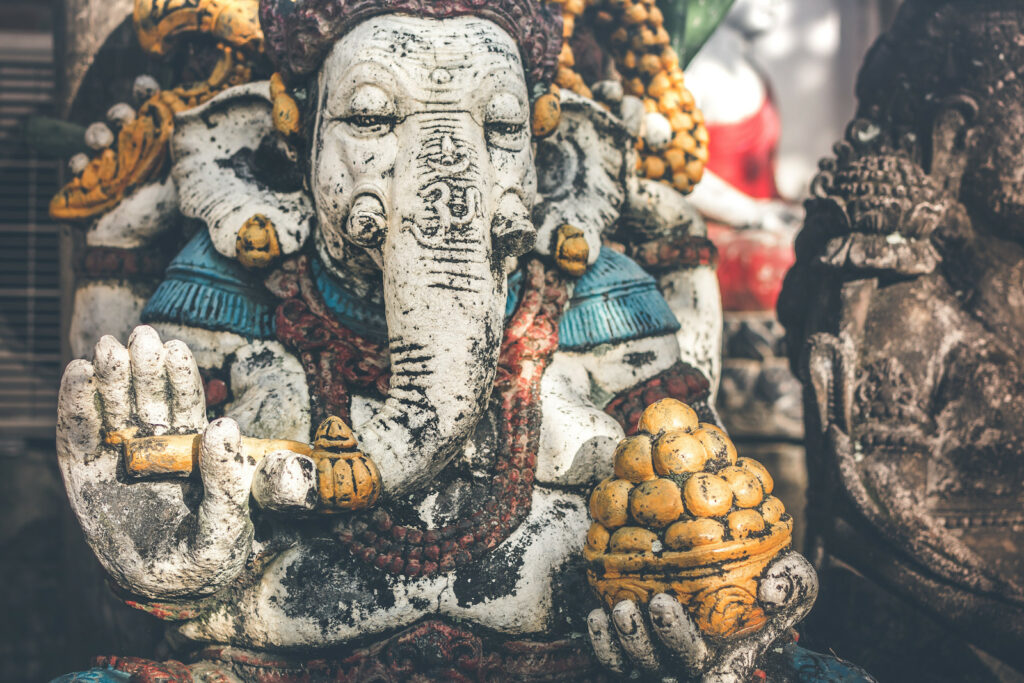The Yoga Yamas: An Overview Of The First Limb Of Yoga
The post The Yoga Yamas: An Overview Of The First Limb Of Yoga appeared first on The Yoga Nomads.

If you’ve been practicing yoga for a while, you may be wondering where yoga comes from and what’s behind the poses. As we will explain in this article, there is so much more to this ancient spiritual practice than the shapes you make on the mat.
The eight limbs of yoga are an ideal starting point for learning about yogic philosophy. In particular, the first limb, known as the Yamas, offers vital wisdom on how as yoga practitioners, we should act in the world around us.
So if you’re feeling called to advance in your spiritual growth or personal development journey and start practicing yoga on and off the mat, read on.
An Introduction To Yoga Philosophy

The Yoga Sutras of Patanjali are among the most essential teachings in yoga philosophy. The text is a collection of 195 Sanskrit sutras, compiled during the early centuries CE by Indian sage Patanjali.
One of the most prominent teachings in the yoga sutras is the eight limbs of yoga (or the Ashtanga yoga eight-limbed system). The eight limbs explain how we can reach the goal of yoga, which is to unite the mind, body, and spirit. The eight limbs are:
Yama (moral codes or disciplines)Niyama (observances)Asana (physical postures)Pranayama (breathing techniques)Pratyahara (sense withdrawal)Dharana (concentration)Dhyana (meditation)Samadhi (enlightenment or bliss)Studying Patanjali’s yoga sutras shows that most western yoga classes are teaching an incomplete practice. The physical yoga poses they heavily focus on are just one of the eight limbs a yoga practitioner should follow.
Following the Yamas and Niyamas, practicing breath control, and learning to meditate are equally as crucial as performing yoga postures. Therefore, the yoga sutras show that practicing these ethical principles is essential if you want to authentically and fully practice yoga.
What Are The 5 Yamas?
The five Yamas are best described as moral codes for interacting with the world. Yama, in Sanskrit, means “restraint.” Hence, the five Yamas are things you should restrain from doing to experience harmonious relationships with others and the universe.
However, the sutras do not present them as moral commandments but rather an insight into the results of doing or not doing them. For example, the third Yama, Asteya, shows that if we steal from others, we harm ourselves and them. Therefore, having knowledge of the yoga Yamas can help us make better decisions and gain more self-awareness.
The Patanjali’s yoga sutra that outlines the five Yamas is found in verse 30 of Chapter 2. They are:
Ahimsa (non-harming or non-violence)Satya (truthfulness)Asteya (non-stealing)Brahmacharya (celibacy or’ correct use of energy)Aparigraha (non-greed or non-hoarding)Let’s take a closer look at the five yoga Yamas and how these ancient teachings relate to our day to day life.
Ahimsa

Ahimsa translates to “non-violence” or “non-harming” but extends beyond physical action. Therefore, even if you describe yourself as someone who “wouldn’t hurt a fly,” you may still not be practicing this Yama.
Ahimsa is about showing loving kindness to all living things through thoughts, words, and deeds. Therefore, it doesn’t only mean to do no harm to others physically, but to speak kind words and be conscious of any harmful thoughts you may have, too.
The modern world presents us with many stressors to which we respond by blaming others; we may curse the person who cuts us off in traffic or complain about our boss. Even if the other person is the one in the wrong, Ahimsa says that responding with harmful thoughts, actions, or words may still result in bad karma. According to the eight-limbed path, emotional violence (hurtful thoughts and comments) are no more acceptable than physical violence.
The Yama also means practicing non-violence towards ourselves. While we may not intentionally harm ourselves with a knife, many of us hurt ourselves daily by thinking negatively or even talking badly about ourselves. So to live this Yama means to catch when we say or think we are not good enough and replace it with self-compassion.
Satya

Satya translates to truthfulness, which, as you have probably guessed, means to restrain from lying. However, like all of the Yamas, it goes much deeper, which you can uncover when we break down the word further. The word ‘sat’ literally translates as ‘true essence‘ or ‘true nature’ but is also associated with the term ‘unchangeable.’
We often see what we believe to be the truth as absolute and unchangeable. Still, Satya invites us to look at things differently. Our thoughts, emotions, and moods change frequently, yet, these are the things that create our beliefs and our “truth.” Therefore, when you genuinely understand Satya, you start to see your beliefs from a different perspective, understanding that nothing is absolute.
Yoga practice helps us see things from a different perspective. Through asana, pranayama, and meditation, we practice finding stillness and creating space in our minds. This allows new thoughts and insights to enter and open our minds to the true reality of a situation we previously could not see.
Without yoga practice and self-reflection, our minds can twist reality and tell us things are worse than they really are. This causes us to overact with hateful words, thoughts, or actions (going against Ahimsa) and prevents us from experiencing a tranquil inner life.
Therefore, Satya is not just about restraining from lying to others but also about uncovering our own truth. It also sends the message that to be truthful to others, we must first be honest with ourselves.
Asteya

Asteya translates as non-stealing. While most of us know that stealing or robbing others’ possessions is wrong, the meaning of Asteya also encompasses the act of non-stealing from the environment and ourselves.
Therefore, you could say that Asteya means to refrain from doing anything that may take mother nature out of harmony. However, with a topic as broad as sustainability, practicing Asteya can range from using reusable grocery bags to prevent pollution to going vegan to prevent rainforests from being cleared for animal agriculture.
So how do we practice Asteya towards ourselves? Asteya is closely linked to Ahimsa. When we think self-deprecating thoughts, we are not only harming ourselves, but we are also self-sabotaging. For example, imagine you see an ad for your dream job, for which you have the qualifications and experience.
If you have low self-worth, your mind will start telling you all sorts of reasons why you are “not good enough” for the role and how they won’t employ you. Now, suppose you allow the negative self-talk and cannot rise above it. In that case, you are not only hurting your soul; you’re stealing the opportunity and success you deserve from yourself.
Brahmacharya

Brahmacharya is the Yama that people struggle to understand the most and find relevant in our modern life. Brahmacharya is commonly translated as celibacy, something that ancient yogis would practice to progress down the yogic path and experience union with the universe.
However, the most accurate translation of Brahmacharya is ‘behavior which leads to Brahman.’ In Hinduism and yogic teachings, Brahman is ‘the creator’ or, more simply, a higher power. So Brahmacharya can be seen as the ‘right use of energy.’ It is believed if you use and direct your power (including sexual energy) in the right way, you will become closer to God.
In terms of sexual energy, practicing Brahmacharya in the 21st century could be seen as protecting your energy by being mindful of the people you have sexual relations with. Or in other words, it is about selecting your sexual partners carefully, as there is a belief that we consume the energy our sexual partners carry.
However, in a more general sense, Brahmacharya is about directing your energy away from external desires that can harm your physical and mental health. These include fast food, gambling, drinking, and drugs. By using your energy correctly and looking for happiness within rather than externally, you will experience more peace and joy.
Aparigraha

The Sanskrit word Aparigraha means non-greed and non-possessiveness. So this Yama refers to not collecting and hoarding material possessions (something many of us are guilty of) and not trying to control others.
Aparigraha is not about renouncing all our possessions and becoming monks, though. Instead, Aparigraha teaches us to take just what we need rather than be greedy. For example, if you’ve ever been to an all-you-can-eat buffet, you may have taken more food than you could eat. This probably resulted in wasted food or overeating and feeling bad. Either way, you most likely learned your lesson and took less food the next time.
We can practice the principle of non-greed in all aspects of our life, not just by finding self-discipline at buffets. Greed stems from a deep-seated scarcity mentality, the belief that there is not enough. This leads us to fight against others for promotions and pay rises at work or buy excess food from the grocery store as soon as the news mentions possible shortages.
The key to mastering Aparigraha is changing that mentality and thinking from an abundance mindset. The need for competition or hoarding diminishes when you believe there is more than enough to go around. To reach this mindset, you must let go of your current expectations around money and attachments to your material possessions. When you can release the desire for outer wealth, that’s when you will experience true inner wealth.
How To Incorporate The Yamas Into Yoga Practice

Once you understand the Yamas, you see what an excellent tool for self-study they are. We discussed how to practice Yamas in daily life, but how can you practice them on your yoga mat?
Ahimsa
As Ahimsa involves the way we treat ourselves, listen to what your mind tells you during your yoga practice and the tendencies you have. For example, do you tend to push yourself further in a yoga pose even if you feel pain in the body? Or do you automatically dismiss trying more advanced postures because of the belief that you are not good enough?
There are many ways we can cause harm to ourselves on the mat, both physically and emotionally. So to practice this Yama during your yoga practice, set the intention to treat yourself with love, respect, and compassion.
Take time in each posture to notice how your body feels and what it asks for. After a while, you’ll start hearing whether your body is telling you to go deeper or back away. This way, you’ll prevent harm and move through your practice, giving your body precisely what it needs.
Satya
In yoga therapy, both Ahimsa and Satya are closely related. Sometimes, to practice Ahimsa (respecting our body) means to practice Satya (accepting the truth) too. For example, we must first be honest regarding our body’s limitations. Then we can make the right decisions about how we treat ourselves.
Accepting the truth also involves acknowledging that our bodies and minds are constantly changing. One day, we may be flexible enough to achieve the full splits. However, another day, our hamstrings could have excess tightness, preventing us from doing the posture.
If you can accept that there will be ups and downs in your practice, like in daily life, you’ll be able to connect to your true self, making finding peace within much easier. So to practice Satya in your daily practice, set the intention to honor and accept how your body and mind are feeling on that particular day.
Asteya
You may think Asteya is a Yama that cannot be practiced on the mat, but this is not the case. One way to describe stealing is wanting more than you deserve or are entitled to. Sometimes in a yoga class, we may look at the more advanced practitioners and wish we could do the postures they can or with as much ease and grace as them.
This feeling may be due to a lack of patience or the desire to reach an advanced level without sufficient time and effort. However, if there was a way to do every yoga pose perfectly without putting in years of practice, this would be stealing.
What’s more, if you attempt a challenging posture when you are new to the practice, you could end up hurting yourself, going against Ahimsa too. So to practice Asteya, set the intention to honor where you are right now and focus on the process of the journey, not the destination.
Committing to being non-judgemental and non-competitive in a yoga class will help in other ways too. For example, you’ll be less likely to compare yourself with the other students, wishing your body looked like theirs.
Brahmacharya
As Brahmacharya is about using and directing your energy the right way, practicing this Yama on the mat means focusing on the practice’s deep benefits rather than the superficial ones. Therefore, you should see yoga as a holistic tool for health, wellbeing, and spiritual development rather than as a way to get fit and create a nice body.
One way to do this is to incorporate more meditation, pranayama, and spirituality in your sessions, rather than focusing solely on the physical movements. You could also attend classes at a yoga studio rather than a gym. In this setting, you will receive a more complete and well-rounded practice, allowing you to get more in touch with your inner self.
Therefore, to practice Brahmacharya, set an intention to practice yoga in a balanced way, benefitting your mind, spirit, and body.
Aparigraha
Aparigraha is about letting go of expectations and the need to feel in control, which can significantly help us on the mat. Setting goals in your asana practice is excellent, as it helps to keep you focused and progress further. However, suppose you set unrealistic expectations, like mastering the forearm stand in one week. In that case, disappointment and negative self-talk are all you will end up with.
Therefore, it’s best to set intentions based on a feeling you want to cultivate during your practice rather than a shape you want to master. This will help you get out of the scarcity mindset and break the belief that you need to achieve specific postures by certain times. By approaching your practice with an attitude of abundance, you’ll be able to practice with non-attachment to the outcomes. Thus, you will enjoy the process (and the results) much more.
Final Thoughts

As you can see, the Yamas provide a path to self-realization. By being conscious about how you act towards others, you also start to treat yourself better. When you start living the Yamas, you begin your journey to a more peaceful, joyful, and ethical life. From here, you can learn about the second of the eight limbs of yoga and the next stage of your spiritual development; the five Niyamas.

 Aliver
Aliver 





























.jpg&h=630&w=1200&q=100&v=6e07dc5773&c=1)

